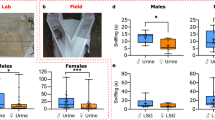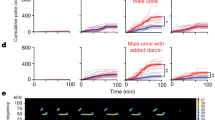Summary
The sternal gland secretion of male and female tupaias was rubbed off with filter paper, and the information conveyed by these “scent marks” was tested with individuals of both sexes in a T-maze.
-
1.
Tupaias are able to distinguish between the sexes and to recognize specific individuals by the odor of the sternal gland secretion.
-
2.
If maintained under constant laboratory conditions, fertile male tupaias produce sternal gland secretions which are unique to each individual. This uniqueness is very stable: The information conveyed remained the same, no matter whether the scent marks were freshly prepared or stored for up to 8 months at room temperature.
-
3.
If the sternal gland secretion of a fertile male tupaia is smeared over that of another male, the original odor is no longer recognized.
Similar content being viewed by others
Literatur
Beauchamp, G. K., Berüter, J.: Source and stability of attractive components in guinea pig (Cavia porcellus) urine. Behav. Biol.9, 43–47 (1973)
Berüter, J., Beauchamp, G. K., Muetterties, E. L.: Mammalian chemical communication: perineal gland secretion of the guinea pig. Physiol. Zool.47, 130–136 (1974)
Bronson, F. H.: Pheromonal influence on reproductive activities in rodents. In: Pheromones (ed. M. C. Birch), p. 344–365. Amsterdam: North-Holland Publ. Co. 1974
Carr, W. J., Caul, W. F.: The effect of castration in rat upon the discrimination of sex odours. Anim. Behav.10, 20–27 (1962)
Carr, W. J., Loeb, L. S., Dissinger, M. L.: Responses of rats to sex odors. J. comp. physiol. Psychol.59, 370–377 (1965)
Gleason, K. K., Reynierse, J. H.: The behavioral significance of pheromones in vertebrates. Psychol. Bull.71, 58–73 (1969)
Henckel, K. O.: Das Primordialcranium von Tupaia und der Ursprung der Primaten. Z. Anat. Entw.-Gesch.86, 204–227 (1928)
Holst, D. v.: Sozialer Stress bei Tupajas (Tupaia belangeri). Die Aktivierung des sympathischen Nervensystems und ihre Beziehung zu hormonal ausgelösten ethologischen und physiologischen VerÄnderungen. Z. vergl. Physiol.63, 1–58 (1969)
Holst, D. v.: Sozialverhalten und sozialer Stre\ bei Tupajas. Umschau73, 8–12 (1973)
Holst, D. v.: Social stress in the tree-shrew: its causes and physiological and ethological consequences. In: Prosimian biology (eds. R. D. Martin, G. A. Doyle, A. C. Walker), p. 389–411. London: Duckworth 1974
Holst, D. v., Buergel-Goodwin, U.: The influence of sex hormones on chinning by maleTupaia belangeri. J. comp. Physiol.103, 123–151 1975a
Holst, D. v., Buergel-Goodwin, U.: Chinning by maleTupaia belangeri: The effects of scent marks of conspecifics and of other species. J. comp. Physiol.103, 153–171 1975b
Loo, S. K.: A comparative study of the nasal fossa of four nonhuman primates. Folia primat.20, 410–422 (1973)
Loo, S. K., Kanagasuntheram, R.: The nasal fossa ofTupaia glis andNycticebus coucang. Folia primat.16, 74–84 (1971)
Lydell, K., Doty, R. L.: Male rat odor preferences for female urine as a function of sexual experience, urine age, and urine source. Hormones Behav.3, 205–212 (1972)
Meinel, W., Woehrmann-Repenning, A.: Zur Morphologie und Histologie des Geruchsorgans von Tupaia glis (Diard, 1820). Folia primat.20 294–311 (1973)
Michael, R. P.: Determinants of primate reproductive behaviour. Acta endocr. (Kbh.)166, 322–361 (1972)
Schultz, E. F., Tapp, J. T.: Olfactory control of behavior in rodents. Psychol. Bull.79, 21–44 (1973)
Spatz, W.: Beitrag zur Kenntnis der Ontogenese des Cranium vonTupaia glis (Diard, 1820). Morph. Jb.106, 321–416 (1964)
Sprankel, H.: Histologie und biologische Bedeutung eines jugosternalen Duftdrüsenfeldes beiTupaia glis (Diard 1820). Verh. dtsch. zool. Ges.55, 198–206 (1961)
Whitten, W. K., Bronson, F. H.: The role of pheromones in mammalian reproduction. In: Communication by chemical signals (eds. J. W. Johnston, Jr., D. G. Moulton, A. Turks), p. 309–325. New York: Appleton-Century-Crofts 1970
Author information
Authors and Affiliations
Additional information
Mit Unterstützung durch die Deutsehe Forschungsgemeinschaft.
Rights and permissions
About this article
Cite this article
Holst, D.v., Lesk, S. über den Informationsinhalt des Sternaldrüsensekretes mÄnnlicher und weiblicherTupaia belangeri . J. Comp. Physiol. 103, 173–188 (1975). https://doi.org/10.1007/BF00617120
Received:
Issue Date:
DOI: https://doi.org/10.1007/BF00617120




